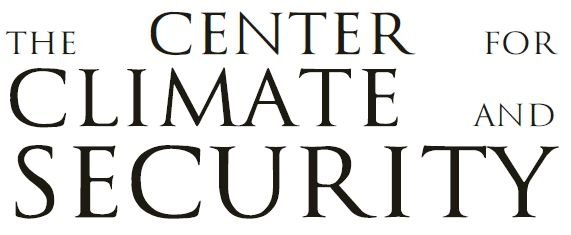Climate Security After the COP: Next Steps for the United States
Submit a question
“Climate change is an increasingly destabilizing force—an accelerating destabilization force—and it’s impacting our operational environment, it’s creating new missions, and our allies and partners are going to be called to respond to these increased demands,” said Brigadier General Rebecca Sonkiss, Deputy Director for Counter Threats and International Cooperation at the Joint Staff J5, at a recent event hosted by the Wilson Center and the Center for Climate and Security. At the event, senior U.S. Government officials reflected on the significance of the Biden administration’s new climate security reports and how climate security is being prioritized and coordinated across defense and development, providing insight into the administration’s whole-of-government approach.
Adapting to a new operational environment for defense
“When climate hazards converge and compound there are likely going to be unprecedented challenges for governments, including the United States as well as our allies and partners, and we have to be ready to work with them in responding to these missions—which means we need to train and exercise together in advance of the need to respond,” said BG Sonkiss. Security cooperation front is a big space that we’re working in; it’s about building that resiliency in advance, she said.
Accelerating climate hazards will also affect the military’s readiness and “ability to project combat power.” As a result, “the climate lens is being integrated across all strategic and policy documents of the Department of Defense,” said Kim Crusey, Climate and Arctic Chief for the Office of the Undersecretary of Defense for Policy (OSD/P). Importantly, the Department of Defense will incorporate climate risks into top-level strategies like the National Defense Strategy and the National Military Strategy. “I think everything kicks off with the NDS,” said Crusey. “That is the North Star for how the department is going to be looking—prioritizing—and that then seeps down to other important planning and guidance documents.”
“Not only are we looking at our capabilities but we are part of a network—an alliance— that a lot of our competitors don’t have. So that increases our ability to look at resilience, and look at how we generate power,” said Crusey. OSD/P is working closely with functional desks and regional desks like East Asia and Africa, who are learning from their counterparts about the effects of climate change in their regions.
Integrating climate across development portfolios
Given its diverse portfolio and presence on the ground in some of the most climate-vulnerable parts of the world, USAID is uniquely positioned to integrate climate security across various sectors, said Teresa McGhie, Deputy Assistant Administrator of USAID’s Bureau of Conflict Prevention and Stabilization (CPS). “We think of climate security as human security,” said McGhie. “With the localization, what we’re trying to do is lean in on building civil society and the voice of the people in a lot of the countries where we work—we want to empower those people.”
CPS has staff dedicated to the intersection of conflict and climate, said McGhie, which allows them to integrate climate security into USAID’s agriculture, water, economic growth, governance, civil society strengthening, and education programming. USAID has also set ambitious targets through its draft 2022-2030 Climate Strategy, including reducing six billion tons of carbon dioxide emissions, conserving 100 million hectares of critical landscapes, and mobilizing $150 billion in climate finance by 2030.
Creating new “muscle memory’ and bring climate to the table at the NSC
The National Security Council (NSC) is coordinating new inter-agency collaborations on climate-related strategies to “[create] new muscle memory” for climate security, said Jennifer DeCesaro, NSC Director for Climate Security and Resilience. For example, the recent report on climate change and migration came from an NSC-led collaboration between defense, diplomacy, development, and all the federal science agencies. Instead of creating another silo for climate change, the Biden administration is applying a “climate lens” to all interagency work, said DeCesaro. Even as non-climate focused strategies are developed, “climate is at the table” and will be “infused throughout” the process, said DeCesaro, citing the Interim National Security Strategic Guidance as an example.
Panelists shared a number of examples of interagency cooperation as essential to countering climate hazards. For example, USAID depends on the DoD for “cost-intensive climate analysis and forecasting,” and in turn places humanitarian and stabilization advisors in every combatant command, said McGhie. DeCesaro pointed to the Climate Security Working Group, which is being relaunched as a forum to strategically pursue new opportunities for collaboration between departments and agencies, including ones that have not traditionally been involved in climate security work. Crusey pointed to the Department of Defense’s collaboration with USAID on conflict-sensitive climate interventions. “If we are doing conflict-sensitive climate interventions,” said Crusey, “we need to be aware of where there are potential community fault lines. So what may be seen as an innocuous act regarding water scarcity could actually exacerbate already existing tensions—that’s a top-line thought I have as we work with our other policy offices that work closely with USAID.”
Recognizing supporting lines of effort and opportunities in climate response
Far from distracting the Department of Defense from its competition with China, tackling climate change is a “supporting line of effort,” said BG Sonkiss. “China is the pacing threat, it is the challenge, but I must be able to provide more fighting capability in whatever environment we’re in,” she said. “We have to respond to how industry is moving as well…if industry is shifting to different vehicles, we’re relying upon industry as we build our force as well in many ways so it doesn’t change the fact of our focus. It changes how we prepare.”
“Climate change is forcing the U.S. National Security Community to re-examine its assumptions about how the world works. No longer are past understandings of the climate a good predictor of the future,” said Erin Sikorsky, Director of the Center for Climate and Security, in her opening remarks. “But while climate insecurity poses real risk,” said Lauren Risi, Director of the Wilson Center’s Environmental Change and Security Program, “there is also a real opportunity to get the response right through U.S. leadership and partnership with the international community, civil society, NGOs and multilateral organizations.”
“While we look at climate change mostly as a threat it does actually provide an opportunity for us,” said McGhie. “We are in most of the countries that are at risk or most vulnerable to climate change…those governments and the people of those countries, they understand it as a risk already and some of them are already seeing the effects of it. Even in countries where we have a hard time finding common ground to actually work together on something, this is a hook that gives us that common ground…it really does help us to create a better bond with those countries and to work more closely with those governments.”
This summary was written by Joon Hwang, a research assistant with the Center for Climate and Security.
Speaker

Introduction

Author, Threat Multiplier: Climate, Military Leadership & the Fight for Global Security.
Moderator

Panelists
Hosted By

Environmental Change and Security Program
The Environmental Change and Security Program (ECSP) explores the connections between environmental change, health, and population dynamics and their links to conflict, human insecurity, and foreign policy. Read more


Africa Program
The Africa Program works to address the most critical issues facing Africa and US-Africa relations, build mutually beneficial US-Africa relations, and enhance knowledge and understanding about Africa in the United States. The Program achieves its mission through in-depth research and analyses, public discussion, working groups, and briefings that bring together policymakers, practitioners, and subject matter experts to analyze and offer practical options for tackling key challenges in Africa and in US-Africa relations. Read more


Canada Institute
The mission of the Wilson Center's Canada Institute is to raise the level of knowledge of Canada in the United States, particularly within the Washington, DC policy community. Research projects, initiatives, podcasts, and publications cover contemporary Canada, US-Canadian relations, North American political economy, and Canada's global role as it intersects with US national interests. Read more


China Environment Forum
China’s global footprint isn’t just an economic one, it’s an environmental one. From BRI investments in Africa and Asia to its growing presence in Latin America, understanding China’s motivations, who stands to gain - and who stands to lose - is critical to informing smart US foreign policy. Read more


Global Europe Program
The Global Europe Program is focused on Europe’s capabilities, and how it engages on critical global issues. We investigate European approaches to critical global issues. We examine Europe’s relations with Russia and Eurasia, China and the Indo-Pacific, the Middle East and Africa. Our initiatives include “Ukraine in Europe”—an examination of what it will take to make Ukraine’s European future a reality. But we also examine the role of NATO, the European Union and the OSCE, Europe’s energy security, transatlantic trade disputes, and challenges to democracy. The Global Europe Program’s staff, scholars-in-residence, and Global Fellows participate in seminars, policy study groups, and international conferences to provide analytical recommendations to policy makers and the media. Read more


Kissinger Institute on China and the United States
The Kissinger Institute works to ensure that China policy serves American long-term interests and is founded in understanding of historical and cultural factors in bilateral relations and in accurate assessment of the aspirations of China’s government and people. Read more


Mexico Institute
The Mexico Institute seeks to improve understanding, communication, and cooperation between Mexico and the United States by promoting original research, encouraging public discussion, and proposing policy options for enhancing the bilateral relationship. A binational Advisory Board, chaired by Luis Téllez and Earl Anthony Wayne, oversees the work of the Mexico Institute. Read more


Polar Institute
Since its inception in 2017, the Polar Institute has become a premier forum for discussion and policy analysis of Arctic and Antarctic issues, and is known in Washington, DC and elsewhere as the Arctic Public Square. The Institute holistically studies the central policy issues facing these regions—with an emphasis on Arctic governance, climate change, economic development, scientific research, security, and Indigenous communities—and communicates trusted analysis to policymakers and other stakeholders. Read more

